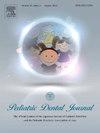Maternal hyperthyroidism in rats causes histomorphometric changes in the cranio-dental development of rat offspring at weaning
IF 0.6
Q4 DENTISTRY, ORAL SURGERY & MEDICINE
引用次数: 0
Abstract
Introduction
Gestational hyperthyroidism is an important cause of bone modifications in offspring, resulting from changes in endochondral growth. However, its effect on the craniodental development in offspring is unknown.
Objective
The objective of this study was to demonstrate the effect of maternal hyperthyroidism on the craniodental development of offspring.
Methods
Five pregnant Wistar rats with hyperthyroidism and five euthyroid rats were used in this study. At weaning, three pups per mother were selected from both groups. Blood was collected from the mothers on the day of birth of their offspring and from pups at weaning to measure plasma-free thyroxine levels.
Results
The influence of maternal hormones on offspring was confirmed by thyroid histomorphometry. The size of the rostro-caudal and latero-lateral axes of the skull, frontal bone width, and the thicknesses of the sutures and the bones were measured. In the molar teeth, the thicknesses of the dentin, pre-dentin, and odontoblast layers, as well as the thickness of the periodontal ligament, were evaluated. The concentration of free T4 was higher in hyperthyroid rats. The height of the thyroid follicular epithelium was lower in offspring of hyperthyroid mothers. Additionally, these offsprings showed a reduction in the width of the frontal bones and an increase in suture thickness. The molars in the hyperthyroid mothers showed a reduction in the thickness of the odontoblast and pre-dentin layers and an increase in the thickness of the periodontal ligament.
Conclusion
We conclude that maternal hyperthyroidism in rats causes significant changes in the cranialdental development of offspring.
母鼠甲状腺功能亢进引起断奶后大鼠后代颅牙发育的组织形态学改变
妊娠期甲状腺功能亢进是子代骨改变的重要原因,由软骨内生长改变引起。然而,其对后代颅齿发育的影响尚不清楚。目的探讨母亲甲状腺功能亢进对子代颅齿发育的影响。方法以5只甲状腺功能亢进的妊娠Wistar大鼠和5只甲状腺功能正常的大鼠为研究对象。断奶时,每只母鼠分别从两组中选择3只幼鼠。研究人员在幼鼠出生当天和断奶时分别从幼鼠母亲和幼鼠身上采集血液,测量血浆游离甲状腺素水平。结果甲状腺组织形态测定证实了母体激素对子代的影响。测量颅骨的前尾轴和前后轴的大小、额骨宽度、缝合线和骨头的厚度。在磨牙中,评估牙本质、牙本质前层和成牙细胞层的厚度以及牙周韧带的厚度。甲状腺功能亢进大鼠游离T4浓度较高。甲状腺功能亢进母亲的后代甲状腺滤泡上皮高度较低。此外,这些后代表现出额骨宽度的减少和缝线厚度的增加。甲亢母牙的磨牙显示成牙细胞和牙本质前层的厚度减少,牙周韧带的厚度增加。结论母鼠甲状腺功能亢进对子代颅牙发育有明显影响。
本文章由计算机程序翻译,如有差异,请以英文原文为准。
求助全文
约1分钟内获得全文
求助全文
来源期刊

Pediatric Dental Journal
DENTISTRY, ORAL SURGERY & MEDICINE-
CiteScore
1.40
自引率
0.00%
发文量
24
审稿时长
26 days
 求助内容:
求助内容: 应助结果提醒方式:
应助结果提醒方式:


